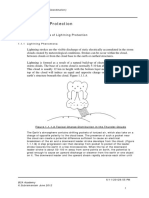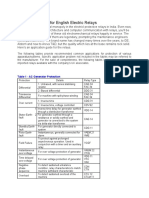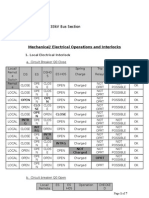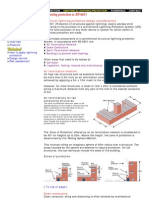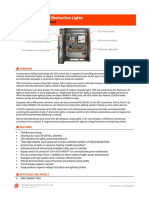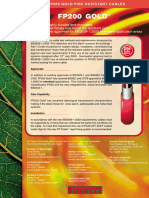HONG KONG COLLEGE OF ENGINEERING
Power Supplies For Building Services Engineering
Earthing of Power
Earthing
Syllabus
Connections to earth Types of system earthing Earthing system in Hong Kong Earth electrode
Earthing
�References
BS7430:1998 EMSD : Code of Practice for the Electricity (Wiring) Regulations, 1997 F. Porges, The design of electrical services for buildings, 1989 IEE Wiring Regulations : amended 16th Edition, Dec.1994 (BS7671) J.C.F. Wong, Low Voltage Electrical Installation Handbook, 1992
Earthing 3
1.0 Introduction
Power Supply to urban areas (HV):
11kV via Delta/Star connected Tx (up to 1500kVA) HV Supply cable : 3-core Al paper insulated, lead-sheathed and double steel tape armoured. 380/220V 3-phase 4-wire distribution winding 3-phase or single-phase
Earthing 4
Building (LV) :
�1.0 Introduction
The primary purposes of the earthing system of a building are to ensure that a safe environment is maintained for the occupants and to protect equipment from damage in the event of a fault.
Earthing
2.0 Connections to Earth
Low voltage system earthing
Power generation, transmission and distribution Control of undesirable static electricity Lightning protection Telecommunications
Earthing 6
Low voltage equipment earthing
Earthing of lightning protection system
Functional earthing of equipment
�2.0 Connections to Earth
Types 1. Low voltage system earthing
z z z
Purposes As reference potential Protect insulation under fault condition As return path for leakage current Complete circuit loop for each fault currents Reduce touch voltage (in some cases) Prevent electric shock Short-circuit protected structure Provide low resistance path for streamer Communication path As signalling path Reduce noise and cross-talks Stabilise battery potential and equipment potential Prevent electric shock Computer earth Reduce interference Stabilise equipment potential with respect to earth
2.
Low voltage equipment earthing Earthing of lightning protection system Functional earthing of equipment
z z z
3. 4.
z z z
Earthing
3.0 System Earthing
System Earthing :
Installation + Source : Electrical System Essential to the proper operation of the system At least one point of a system is earthed Preserve security of system Protect associated electrical plant Potential of each conductor restricted to a value No conductor may rise to a potential greater than the insulation rating Direct connection to earth of the neutral (N) of a 3phase system or one pole of a single-phase system at the supply source
Earthing 8
3.0 System Earthing
Common or separate earths for LV system and Tx ? (Common earth : coupling between HV and LV systems) Consider :
Probability of breakdown of Tx between HV and LV.
z
Reduced by the use of common earth
Safety of human and property due to the potential raised by the resultant HV fault current.
z
Only arises if the resistance of earth connection is not low enough (rare because earth electrode 1 ) Earth electrode : sized to withstand the HV fault current
Earthing
3.0 System Earthing
Local power companies
Tx substation earth bar : bonded the armouring of HV supply cables and metalwork Additional connection to earth : earth rod installed along HV cable trenches bonded to cable armouring and the earth bar Tx neutral : connected to earth bar system earth connection
Earthing
10
�3.0 System Earthing
Earthing
11
3.0 System Earthing
Earth electrode system
Only return path for HV fault currents Theoretical maximum current of a HV earth fault 18.4 kA [i.e. 350 MVA at 11kV (3-phase)] Complex including finite resistance of HV supply cable armouring and/or sheath, system earth electrodes and other earth connections Actual current carried by LV << Theoretical maximum But, HV earth fault possible consequences on step and touch voltage adjacent to LV earth electrode system
Earthing 12
Actual earthing system
�3.0 System Earthing
For withstanding thermal effects in the earth electrode system (if it is the only return path for HV fault currents) :
HV system earth electrode resistance Characteristics of overcurrent protection of HV System, e.g. inverse time characteristic (fuses or relays)
Earthing
13
4.0 Equipment Earthing
Electrical system :
Concerns the safety of personnel and plant A key function of equipment earthing is to provide a controlled method to prevent the build up of static electricity, thus reducing the risk of electrical discharge in potentially hazardous environments. Generally, a resistance to earth of less than 106 W will ensure safe dissipation of static electricity in all situations.
Earthing 14
�4.0 Equipment Earthing
Hong Kong :
Many of exposed parts of fixed equipment : metallic (switchboards, conduits, motor frames, ) ensure the safety of human life, animals and property Equipment Earthing
Earthing 15
Earthing :
4.0 Equipment Earthing
X = bonding conductor between system earth and equipment earth (consumers earth) terminals.
Earthing
16
�4.0 Equipment Earthing
Effective and rapid operation of protective device in the event of earth fault current. Protect against danger to life through shock due to the exposed metalwork of the installation Against electric shock and fire risk : earthed equipotential bonding and automatic disconnection of supply Electricity Supply Regulations : Equipment Earthing little mentioned
Earthing 17
5.0 Functional Earthing
Separate earthing for functional purposes Telecommunications and computer installations Earthing on power side for electricity safety Signal grounding for noise-free operation of electronics and subsequent reliability considerations To limit voltage rise of voltage transient spikes on equipment earthing terminal
Earthing 18
�5.0 Functional Earthing
LV earth and functional earth connections : keep away to each other
No any independent functional earthing electrodes International Telegraph and Telephone Consultative Committee (CCITT) manual : operation requirements
Earthing
19
5.0 Functional Earthing
Safety of human being Protection of equipment Legal requirements Reduce cross-talks and noise
Earthing
20
10
�5.0 Functional Earthing
Difficulties
Uncontrolled connections and galvanic couplings of various earth electrode Fire and danger to human life due to the potential difference of various earth electrodes connections. Currents flow through metal structures and cause corrosion.
Earthing
21
5.0 Functional Earthing
Solution Principle :
Keep all points earthed at the SAME potential Either Star or Mesh configuration
Earthing
22
11
�5.0 Functional Earthing
Solutions
Star-shaped configurations
z
Reduce circulating currents Increase effective conductor cross section for currents flowing towards the earth and no excessive voltage drops More practical and effective than bar type Easier and safer Prevent connecting to remote earths Because a noise and surge path introduced
Earthing 23
Mesh configuration
z
Ring type earth collector
z z
Data processing equipment
z z
6.0 Types of System Earthing
First letter
Earthing arrangement at the source of energy (Supply side) T Direct connection of one or more points to earth I All live parts isolated from earth or one point connected to earth through an impedance
Earthing
24
12
�6.0 Types of System Earthing
5 Common types of electrical system
TN-S TN-C TN-C-S TT IT
Earthing
27
6.1 TN-S System
A system have a separate neutral conductor and a separate protective earth conductor, the latter may be the metallic cover of the cable or a separate conductor.
Protective conductor (PE)
z
The metallic covering of the cable supplying the installations or a separate conductor
Exposed conductive parts connected to PE via the main earthing terminal of the installation.
Earthing 28
14
�Types of Electrical Systems by means of combination arrangement of earth connections at source and at load. Each type of system is identified by 2 capital letters. The first letter denotes the earthing arrangement at the source of energy (supply side), and T = direct connection of one or more points to earth I = all live parts isolated from earth or one point connected to earth through an impedance The second letter denotes the relationship of the exposed conductive parts of the installation to earth (load side), and T = direct electrical connection of the exposed conductive parts to earth, independently of the earthing of any point of the source of energy (independent earth) N = direct electrical connection of the exposed conductive parts to the earthed point of the source of energy. For a. c., it is usually the neutral point (dependent earth) A third and/ or a fourth letter are/is designated to each TN system to identify the relationship of the above electrical earth connection with neutral and protective conductors S = neutral and protective functions provided by separate conductors C = neutral and protective functions combined in a single conductor
�Based on the definitions of T, I, N, S, C, try to draw the systems; and compare your answer with those diagrams in the following pages. Both H. K. Electric Co. and China Light & Power Co. recommend the use of TT system for their low voltage supply. But C.O.P. of EMSD makes installations perform effectively as TN-S systems in HK.
�6.1 TN-S System
Earthing
29
6.1 TN-S System
Characteristics Advantages
Low earth loop impedance High earth fault current Fast operation of earth fault protective devices Maintain earth continuity when a main earth is broken (earth provided at consumer side) Cost saving for earth fault relays in smaller installations Higher earth fault level Earth fault has a low power factor of fault current
Disadvantages
Earthing
30
15
���6.4 TT System
A system having one point of the source of energydirectly earthed, the exposed conductive parts of the installation being connection to other electrodes electrically independent of the earth electrodes of the source.
Exposed conductive parts connected to an earth electrode (electrically independent of the source earth).
Earthing 37
6.4 TT System
Earthing
38
19
���6.4 TT System
Characteristics
High earth loop impedance Low earth fault current Power companies do not provide earthing for consumers Earth fault has a better power factor of fault current Saves bonding conductor Earth fault relays are frequently required Incurs cost of separate earth Higher touch voltage Create step voltage
Advantages Disadvantages
Earthing
39
6.5 IT System
A system having no direct connection between live parts and earth, the exposed conductive parts of the installation being earth.
Exposed conductive parts connected to an earth electrode. Source connected to earth via earthing impedance or isolated from earth.
Earthing
40
20
��Draw path of Earth Fault Current in TN-C System. It utilizes the neutral as its return path. As performance of earth fault relay assume earth fault current cannot return through the CTs of the relay. Therefore, the return of fault current to the neutral may affect operation of the E/F relay.
�7.0 Earthing System in Hong Kong
EMSD : Code of Practice for the Electricity (Wiring) Regulations
Installation protected by its own electrodes Main earthing terminal of installation bonded to the earthing facilities of the power company
z
Supply by transformer
A bonding terminal provided at supply side Exposed conductive parts of the underground supply cable
Earthing 43
Supply by underground cable
7.0 Earthing System in Hong Kong
Hong Kong earthing arrangement
Combination of TT and TN-S system
z z
Direct from power companys transformers Supplied from underground cable with exposed conductive part at the cable termination Supplied by overhead lines Supplied from underground cable without exposed conductive part at the cable termination
TT system (Rare)
z z
Earthing
44
22
�8.0 Earth Electrode
Design criteria of earth electrode system
Impedance or resistance of the connection to earth Thermal capacity Potential gradients around electrodes Mechanical strength and resistance to corrosion
Earthing
45
8.0 Earth Electrode
Earth rod Earth rod Taper Coupling
Earth rod Driving Head
Earth rod Tape
Earthing
46
23
�9.0 Earth Equipment
The schematic above illustrates the key elements of an effective earthing system.
Earthing 49
9.0 Earth Equipment
Conductor
Above ground, copper, aluminum and steel may be used. Below ground, copper is the most common choice due to its high resistance to corrosion. It is important that earthing conductors should be correctly sized for their application, as they may be required to carry a considerable current for several seconds
Circuit Protective Conductor
A conductor that is installed in order to provide a guaranteed earth return path for an individual circuit. Thereby ensuring fast disconnection times.
Earthing
50
25
�9.0 Earth Equipment
Bonding Conductors Conductors that are installed to electrically link items of metalwork within a building thereby ensuring that an earth fault has a minimum return resistance. Further divided into Equipotential Bonding and Supplementary Bonding. Adequate bonding ensures fast disconnection times and that the touch voltage between metalwork does not exceed 50volts. Electrical bonding may be carried out by a range of means depending upon the type of building and equipment installed. Common means of linking steel frameworks and equipment is with the use of earthing strap or separate conductors connected together using lugs and nuts & bolts. Pipework, conduits etc. may be bonded using custom earth clips.
Earthing
51
9.0 Earth Equipment
Earth rods and plates or any combination are used to achieve an
effective earth depending on the site conditions. Earth rods take advantage of lower resistivity soils at greater depths than normal excavation will allow. Earth plates are used to attain an effective earth in shallow soils with underlying rocks or in locations with large amounts of buried services. They can also provide protection at potentially dangerous places e.g. HV switching positions.
Earth Plate - Solid (Copper)
Earth Plate Lattice (Copper)
Earthing
52
26
�9.0 Earth Equipment
Connectors and terminations
Joints and connections with a good electrical conductivity with high mechanical strength will provide an effective earthing system. Poorly chosen or badly installed joints and connectors can compromise the safe operation of an earthing system.
Exothermic welding connector
Earthing 53
9.0 Earth Equipment
Compression connectors
It produce very robust joints which can be buried in the ground or in concrete. They are ideal for use in situations where exothermic welding is not appropriate and periodic disconnection is not required.
Earthing inspection pit
Inspection pits allow easy access to earth electrodes and conductors to facilitate this procedure.
Mechanical clamps
Where permanent connections are not appropriate, mechanical clamps offer the ideal solution. These are typically used on smaller scale installations where periodic disconnection for testing is required.
Earthing
54
27
�9.0 Earth Equipment
Earth bars
An efficient and convenient way of providing a common earth point. Integral disconnecting links mean the earth bars can be isolated for testing purposes.
Soil conditioning agents
Soil conditioning agents are to be used in areas where required resistivity levels are difficult to achieve. When used as a backfill for earth electrodes, soil conditioning agents effectively act to increase the electrodes surface area thus lowering its resistance to earth.
Earthing
55
9.0 Earth Equipment
Earthing strip Earthing tape clamp
Earth resistance tester
Earthing 56
28
�Earthing
Q&A End of Topic Thank you !
Earthing
59
30








